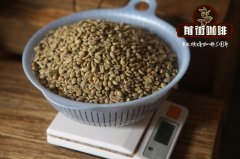What are the taste and flavor characteristics of Brazilian coffee sirado? How to Hand Make Brazilian Café

Professional coffee knowledge exchange more coffee bean information please follow the coffee workshop (Wechat official account cafe_style)
What are the taste and flavor characteristics of Brazilian coffee producing areas? How to make coffee beans from Brazil's Hilado area by hand?
Produced in the prairie with an elevation of 850 MULTHI 1200 meters above sea level, the annual average temperature is about 20 degrees, and the distinct dry and wet seasons and comfortable low temperature form the unique flavor of this bean. Cerrado Caf é Area is the best Brazilian bean in many producing areas of Brazil. It is made from raw beans by sun exposure.
Kenna Handmade Coffee uses beans that have passed through the Rainforest-Alliance Rainforest Conservation Alliance. The Rainforest-Alliance Rainforest Conservation Alliance was founded in 1987 by Daniel R. Katz. The purpose of Rainforest Conservation Alliance is to protect nature and respect local people for enterprises in the world under affordable management requirements, and to produce goods in a way that does not destroy nature, and coffee beans or crops grown in such an environment will be organic standards. In order to protect the earth's environment.
Under its charming and acidic silky flavor, Brazilian Syracuse is still a favorite of sour coffee and a delicious coffee that can not be put down. Product characteristics: Brazil is located in the South American continent, producing about 40 million bags of coffee every year (accounting for about 30% of the global output), making it the number one coffee producer in the world. Coffee beans are mainly produced in five provinces-Parana, Sao Paulo, Minas Gerais, Espirito Santo and Bahia.
It is worth mentioning that the Syrador producing area is located on the platform south of the "Hirado Prairie Climate Zone" covering an area of about 2 million square kilometers across eight provinces in central Brazil. this Hirado grassland is the largest savanna (or tropical savanna) in South America, which is rich in native plants and animals, and its climate and ecological characteristics are obviously different from those of the Amazon Basin in northern Brazil.
The so-called Hirado coffee producing area (Cerrado Coffee Region) refers to the area where the prairie extends to the plateau of 850 ∼ and 1200 meters above sea level in Minas province, which is different from the "southern Minas" which is also located in Minas province.
The flat and open terrain of the prairie is particularly suitable for the establishment of a large manor here, coupled with a clear dry and wet season and a cooler climate on the platform, which synchronizes the ripening time of coffee berries, so the Syrador producing area is unique among many producing areas in Brazil. it can be called a choice of high-quality Brazilian beans.
This raw bean made from the sun has some green prairie and light strawberry aromas in the dry aroma, low acidity but full-bodied with molasses and sweetness. the texture is soft and delicate when the coffee is getting cold, it is bitter and sweet almond chocolate mixed with aromas like blueberries and strawberries, and the complexity and elegance of the sun method can be said to be a blend of fiber. A single product can be carefully savoured and its deep addition to espresso will also bring soft richness and richness.
It retains the unique aroma of drying and the beautiful appearance of beans treated with water. On average, although it is very mild, Brazilian Syracuse is still a sweet coffee that can't bear to let go.
Producing area Region: Syrador region, Minas
Grade: No.2 SC16/18
Altitude Altitude:1100-1300m
Variety Variety: Huangbo Mu (Huangbourne) Yellow Bourbon
Handling method precessing: daily Natural
Harvest season: August-September
Cup test: citrus, chocolate, nuts, cranberries, cloves, mellow and round
Recommended baking degree: Medium-Dark
Flavor characteristics Flavou
Aroma aroma: Clove clove
Flavor flavor: Cocoa,red fruit chocolate, cranberry
Body alcohol: Heavy,syrupy heavy, syrup
Acidity acidity: Juicy fruit acid
The three major boutique coffee producing areas in Brazil are Hilado, South Minas and Mojiana in the central and western part of Minas province. Brazil's Yellow Bourbon is located in the Hilado region of Brazil. However, not all coffee produced in the prairie of Syracuse can bear the name of Syrador. It is only on the plateau of the central and western part of Minas province, which is 1100,000m above sea level and 1300 meters above sea level, that the high altitude and fertile soil make it sweet, mellow and tasteless.
How to make coffee beans from Brazil's Hilado area by hand?
1. Filter paper
two。 Filter cup
3. Coffee pot
4. Hand punch pot
[simple hand-brewed coffee]
[small reminder] the key technology of whether hand-brewed coffee is good or not lies in the process of hand-brewing.
1. The suitable water temperature for each kind of coffee bean is different, most of which are between 88 and 93 degrees.
two。 The amount of water in a cup of coffee is about 200c.c., and the amount of coffee powder is about 11murm 15g.
3. The first water injection is injected from the center and spirally out of the clock.
The amount of water must be kept small and stable, and the routes of water injection do not overlap, and flushing to the filter paper must be avoided.
4. After waiting for the coffee powder to steam in the outermost ring, the coffee powder will gradually puff up.
5. And then from the outside to the inner clock spiral water injection, the same do not repeat the route
Until rushed to the center point, and then spirally rushed out to the outermost ring and stopped, that is, it is finished.
Steps 1 to 3 are the correct brewing steps, if you don't have enough coffee liquid at this time.
Then repeat the first and third steps from the central point again.
It has already been steamed, so there is no need to stay.
Important Notice :
前街咖啡 FrontStreet Coffee has moved to new addredd:
FrontStreet Coffee Address: 315,Donghua East Road,GuangZhou
Tel:020 38364473
- Prev

What are the flavor and taste characteristics of the black diamond treated by the Akaia species of coffee beans in the Hilado region of Brazil?
Professional coffee knowledge exchange more coffee bean information please follow the coffee workshop (Wechat official account cafe_style) Brazil Coffee Hilado coffee beans Akaia species sun-treated black diamond flavor and taste characteristics? Brazil Xilado producing area Akaia species tanning treatment of black diamond Brazil Cerrado Acaia Natural Black Diamond Brazil has been a global Allah in recent years
- Next

Flavor characteristics of Coffee beans in Hilado, Brazil; suggestion on water temperature ratio parameters of hand-brewing Brazilian coffee
Professional coffee knowledge exchange more coffee bean information please pay attention to the coffee workshop (Wechat official account cafe_style) the flavor and taste characteristics of Hillado Coffee in Brazil? How do you drink coffee from the Hiladow region of Brazil? Brazil has always been the largest producer of coffee beans, with a total annual output of about 2.7 million metric tons, accounting for
Related
- Detailed explanation of Jadeite planting Land in Panamanian Jadeite Manor introduction to the grading system of Jadeite competitive bidding, Red bid, Green bid and Rose Summer
- Story of Coffee planting in Brenka region of Costa Rica Stonehenge Manor anaerobic heavy honey treatment of flavor mouth
- What's on the barrel of Blue Mountain Coffee beans?
- Can American coffee also pull flowers? How to use hot American style to pull out a good-looking pattern?
- Can you make a cold extract with coffee beans? What is the right proportion for cold-extracted coffee formula?
- Indonesian PWN Gold Mandrine Coffee Origin Features Flavor How to Chong? Mandolin coffee is American.
- A brief introduction to the flavor characteristics of Brazilian yellow bourbon coffee beans
- What is the effect of different water quality on the flavor of cold-extracted coffee? What kind of water is best for brewing coffee?
- Why do you think of Rose Summer whenever you mention Panamanian coffee?
- Introduction to the characteristics of authentic blue mountain coffee bean producing areas? What is the CIB Coffee Authority in Jamaica?

